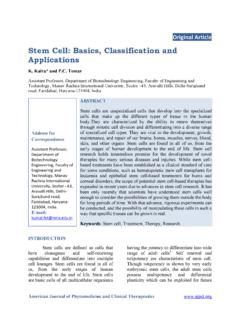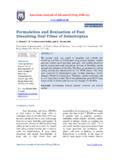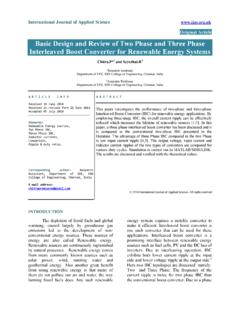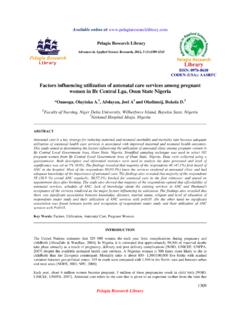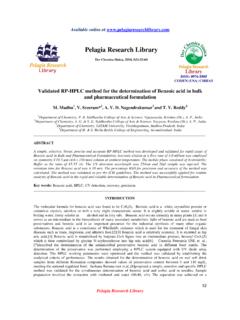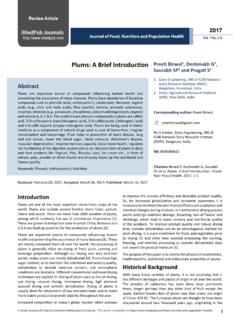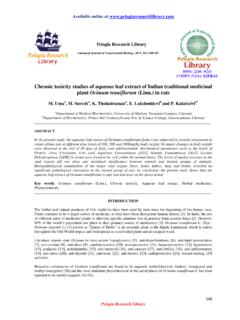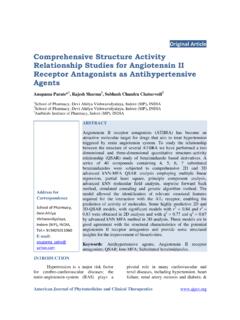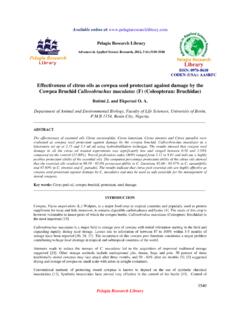Transcription of Food Spoilage: Microorganisms and their prevention
1 Available online at Pelagia Research Library Asian Journal of Plant Science and Research, 2015, 5(4):47-56 ISSN : 2249-7412 CODEN (USA): AJPSKY 47 Pelagia Research Library food spoilage : Microorganisms and their prevention Seema Rawat Department of Botany and Microbiology, H. N. B. Garhwal (Central) University, Srinagar, Uttarakhand, India _____ ABSTRACT food spoilage can be defined as any sensory change (tactile, visual, olfactory or flavour) which the consumer considers to be unacceptable. spoilage may occur at any stage along food chain. spoilage may arise from insect damage, physical damage, indigenous enzyme activity in the animal or plant tissue or by microbial infections.
2 Most natural foods have a limited life. Perishable foods such as fish, meat and bread have a short life span. Other food can be kept for a considerably longer time but decomposes eventually. Enzymes can bring about destruction of polymers in some foods while chemical reactions such as oxidation and rancidity decompose others but the main single cause of food spoilage is invasion by Microorganisms such as moulds, yeast and bacteria. In case of mould spoilage a furry growth covers the food and it becomes soft and often smells bad. Bacterial contamination is more dangerous because very often food does not look bad even though severely infected, it may appear quite normal.
3 The presence of highly dangerous toxins and bacterial spores is often not detected until after an outbreak of food poisoning, laboratory examination uncovers the infecting agent. Key words: food spoilage , Enzymes, Bacterial contamination, food poisoning, Perishable foods. _____ INTRODUCTION food spoilage is a metabolic process that causes foods to be undesirable or unacceptable for human consumption due to changes in sensory characteristics. Spoiled foods may be safe to eat, they may not cause illness because there are no pathogens or a toxin present, but changes in texture, smell, taste, or appearance cause them to be rejected. Some ecologists have suggested these noxious smells are produced by microbes to repulse large animals, thereby keeping the food resource for themselves [1].
4 food loss, from farm to fork, causes considerable environmental and economic effects. The USDA Economic Research Service estimated that more than ninety-six billion pounds of food in the were lost by retailers, foodservice and consumers in 1995. Fresh produce and fluid milk each accounted for nearly 20% of this loss while lower percentages were accounted for by grain piroducts ( ), caloric sweeteners ( ), processed fruits and vegetables ( ), meat, poultry and fish ( ), and fat and oils ( ) [2]. Some of this food would have been considered still edible but was discarded because it was perishable, past its sell-by date, or in excess of needs.
5 There are also environmental and resource costs associated with food spoilage and loss. If 20% of a crop is lost, then 20% of the fertilizer and irrigation water used to grow that crop was also lost. Shelf life of a food is the time during which it remains stable and retains its desired qualities. The wide array of available dairy foods challenges the microbiologist, engineer, and technologist to find the best ways to prevent the entry of Microorganisms , destroy those that do get in along with their enzymes, and prevent the growth and activities of those that escape processing treatments. Troublesome spoilage Microorganisms include aerobic psychrotrophic Gram-negative bacteria, yeasts, molds, heterofermentative lactobacilli, and spore-forming bacteria.
6 Psychrotrophic bacteria can produce large amounts of extracellular hydrolytic enzymes, and the extent of recontamination of pasteurized fluid milk products with these bacteria is a major determinant of their shelf life. Fungal spoilage of dairy foods is manifested by the presence of a wide variety of metabolic by-products, causing off-odors and flavors, in addition to visible changes in color or texture. Seema Rawat Asian J. Plant Sci. Res., 2015, 5(4):47-56 _____ 48 Pelagia Research Library Coliforms, yeasts, heterofermentative lactic acid bacteria, and spore-forming bacteria can all cause gassing defects in cheeses. The rate of spoilage of many dairy foods is slowed by the application of one or more of the following treatments: reducing the pH by fermenting the lactose to lactic acid; adding acids or other approved preservatives; introducing desirable microflora that restricts the growth of undesirable Microorganisms ; adding sugar or salt to reduce the water activity (aw); removing water; packaging to limit available oxygen; and freezing.
7 The type of spoilage Microorganisms differs widely among dairy foods because of the selective effects of practices followed in production, formulation, processing, packaging, storage, distribution, and handling [3]. Scenario of food spoilage worldwide The issue of food losses is of high importance in the efforts to combat hunger, raise income and improve food security in the world s poorest countries. food losses have an impact on food security for poor people, on food quality and safety, on economic development and on the environment. The exact causes of food losses vary throughout the world and are very much dependent on the specific conditions and local situation in a given country.
8 In broad terms, food losses will be influenced by crop production choices and patterns, internal infrastructure and capacity, marketing chains and channels for distribution, and consumer purchasing and food use practices. Irrespective of the level of economic development and maturity of systems in a country, food losses should be kept to a minimum. food losses represent a waste of resources used in production such as land, water, energy and inputs. Producing food that will not be consumed leads to unnecessary CO2 emissions in addition to loss of economic value of the food produced. Economically avoidable food losses have a direct and negative impact on the income of both farmers and consumers.
9 Given that many smallholders live on the margins of food insecurity, a reduction in food losses could have an immediate and significant impact on their livelihoods. For poor consumers ( food insecure or at-risk households), the priority is clearly to have access to food products that are nutritious, safe and affordable. It is important to note that food insecurity is often more a question of access than a supply problem. Improving the efficiency of the food supply chain could help to bring down the cost of food to the consumer and thus increase access. Given the magnitude of food losses, making profitable investments in reducing losses could be one way of reducing the cost of food .
10 But that would, of course, require that financial gains from reduced losses are not outweighed by their costs. How much food is lost and wasted in the world today and how can we prevent food losses? Those are questions impossible to give precise answers to, and there is not much ongoing research in the area. This is quite surprising as forecasts suggest that food production must increase significantly to meet future global demand [4]. Worldwide postharvest fruit and vegetables losses are as high as 30 to 40% and even much higher in some developing countries. Reducing postharvest losses is very important; ensuring that sufficient food , both in quantity and in quality is available to every inhabitant in our planet.

